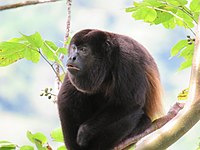
Photo from wikipedia
Space use patterns are the result of complex interactions between individuals and their environment. Although competition with conspecifics, the distribution and availability of food resources and climatic conditions may all… Click to show full abstract
Space use patterns are the result of complex interactions between individuals and their environment. Although competition with conspecifics, the distribution and availability of food resources and climatic conditions may all influence space use by primates, these factors are usually addressed separately. Studies that integrate social, ecological, and physical factors have the potential to improve our understanding of variation in the spatial behavior of primates. We studied two groups of mantled howler monkeys (Alouatta palliata) in Los Tuxtlas, Mexico, to explore how intergroup competition, food availability, and ambient temperature influenced their use of space over 15 months. Loud calls produced by neighboring groups were a determining factor in the variation in the area used per month, daily ranging distance, and travel rate. Food availability did not influence any aspect of spatial behavior, but the distribution of feeding trees affected travel rate. Ambient temperature influenced the frequency and speed of travel. These results suggest that the spatial behavior of howler monkeys is influenced by social (intergroup competition), ecological (food distribution), and physical (ambient temperature) factors, and that the specific effects of these factors vary among measures of space use.
Journal Title: International Journal of Primatology
Year Published: 2018
Link to full text (if available)
Share on Social Media: Sign Up to like & get
recommendations!